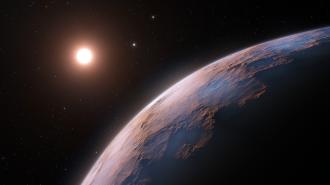Astronomers have discovered a third exoplanet orbiting Proxima Centauri, the star closest to our sun.
“The discovery shows that our closest stellar neighbor seems to be packed with interesting new worlds, within reach of further study and future exploration,” lead author João Faria of the European Southern Observatory (ESO) said in a press release.
Exoplanet hunters: Scientists have two techniques they use to detect exoplanets, planets that orbit stars other than our sun: the transit method and the “wobble” method.
The transit method looks for regular dips in a star’s brightness caused by an exoplanet passing in front of the star.
The “wobble” method is similar, but instead of dips in the star’s brightness, scientists look for a “wobble” in the star’s motion caused by the gravity of an orbiting exoplanet.
The exoplanet orbiting Proxima Centauri is one of the smallest ever discovered.
The challenge: Given that Proxima Centauri is the star closest to our solar system, you might assume its exoplanets were among the first discovered back in the 1980s, but astronomers only just detected the first one in 2016.
That’s because Proxima Centauri might be close (in galactic terms), but its exoplanets are relatively tiny, and exoplanets are easier to see with either method if they’re bigger. More mass makes their effect on their host star easier to spot — they block more starlight or cause a bigger wobble.
What’s new: Thanks to a new instrument on the ESO’s Very Large Telescope in Chile, it seems small exoplanet size isn’t going to be as big of a problem going forward.
This instrument, the Echelle SPectrograph for Rocky Exoplanets and Stable Spectroscopic Observations (ESPRESSO), can detect much smaller wobbling motions than its predecessors — it’s the difference between catching something moving at a human’s walking pace and a snail’s crawling pace.
The newly detected exoplanet around Proxima Centauri is the first spotted by ESPRESSO, and with a mass just a quarter of Earth’s (or twice Mars’), it’s one of the smallest exoplanets discovered by any instrument.
Why it matters: The new exoplanet’s close proximity to Earth is just one reason to be excited about this discovery. The other is that scientists really want to find more small exoplanets — including potentially habitable, Earth-like planets — and ESPRESSO has proven its ability to make that happen.
“This achievement … shows that the radial velocity [“wobble”] technique has the potential to unveil a population of light planets, like our own, that are expected to be the most abundant in our galaxy and that can potentially host life as we know it,” study author Pedro Figueira said.
We’d love to hear from you! If you have a comment about this article or if you have a tip for a future Freethink story, please email us at [email protected].




